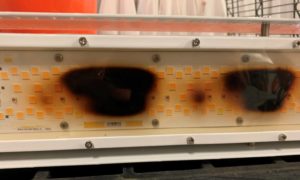Early Scaling-Up Challenges with LED Lighting
The fundamental advantages of light-emitting diode (LED) lighting are clear. They are increasingly efficient at converting electricity into photosynthetic light, and their rated lifetime is much longer than conventional fixtures. However, this is still a relatively new technology and, unfortunately, one can be reminded of that when the jump is made to replace conventional lighting fixtures with LEDs, or when one expands into new production space with LEDs in a commercial setting. Put differently, lab results are great, but commercial installations and scaling up requires even more coordination with engineering, logistics and old-fashioned problem solving.
For any new lighting purchase, a good relationship with a company is critical. Personal sales connections help, and a company can be on the mark with responsive and accurate communication. The opposite can also happen with missed calls, lack of follow up and delays. Consider yourself lucky if you can weed out vendors before a project starts, because if these issues pop up after the first check is cut, you may have little recourse unless you don’t mind mixing brands.
LAMP SELECTION AND PLACEMENT
Once you have determined your desired light intensity, the next step is figuring out lamp type and placement. Companies have come a long way to providing good “light maps,” which provide predictions of how many lamps you will need in your specific production area to provide the target light intensity. The only watch-out we have experienced is if the company is less aware of plant lighting and uses units such as lumens, lux and foot-candles. While those are used for general lighting applications, plant lighting should be communicated based on photons within the photosynthetically active radiation region of the spectrum, and use units such as micromoles per second (μmol×s–1) and micromoles per square meter and second (μmol×m–2×s–1).
Production delays in lamp manufacturing that delay delivery and installation can be common. Therefore, it is prudent to build in extra time on the front end, especially when a lighting project costs at least six figures. In other words, plan for delays.
OTHER CONSIDERATIONS
Once installed, LEDs are not necessarily maintenance free. Problems that have occurred include overheating of diodes that lead to shorts (Figure 1), corrosion of hardware in the highumidity environment of a greenhouse, and faulty drivers that require replacement within months of installation. The manufacturer or supplier typically replaces the faulty fixture(s) at no cost. However, this process takes time and can be frustrating when more than a few fixtures fail.

of this passively cooled fixture overheated and burned the device.
The definition of what constitutes a “greenhouse environment” is not consistent across suppliers. As growers, we know that “high humidity” can mean above 85% consistently. We also know that the temperature set point is what we want at plant height, not the temperature at the height of the lighting fixtures, which can be much higher. A vendor’s experience in the greenhouse industry can help address some of these awareness gaps, but the gaps can exist today.
One way to mitigate some of these issues is to purchase LED fixtures that are qualified horticultural lighting products by the DesignLights Consortium. A fixture must meet several requirements, including a long driver lifetime (at least 50,000 hours), certification by a relevant safety body specifically for horticultural applications, and a five-year warranty. Despite these credentials, however, fixture failures can and still do occur. Therefore, it’s important to purchase fixtures from a reputable and economically stable company (to the best of your knowledge), so that if fixtures do fail, the manufacturer or supplier will still be in business to support the warranty.
Relative to other lighting technologies on the market today, we are still in early days of commercial-scale implementation of LEDs as a supplemental lighting source. The demand for LEDs is huge, and based on the promising science and engineering behind the technology, it is justifiable. Has the demand outpaced the reliable supply of component parts? Will the industry mature fast enough to alleviate the technology’s implementation issues? While we are optimistic, as with any new technology, it is important to know that there can still be some hiccups with commercial implementation.








 Video Library
Video Library 

















